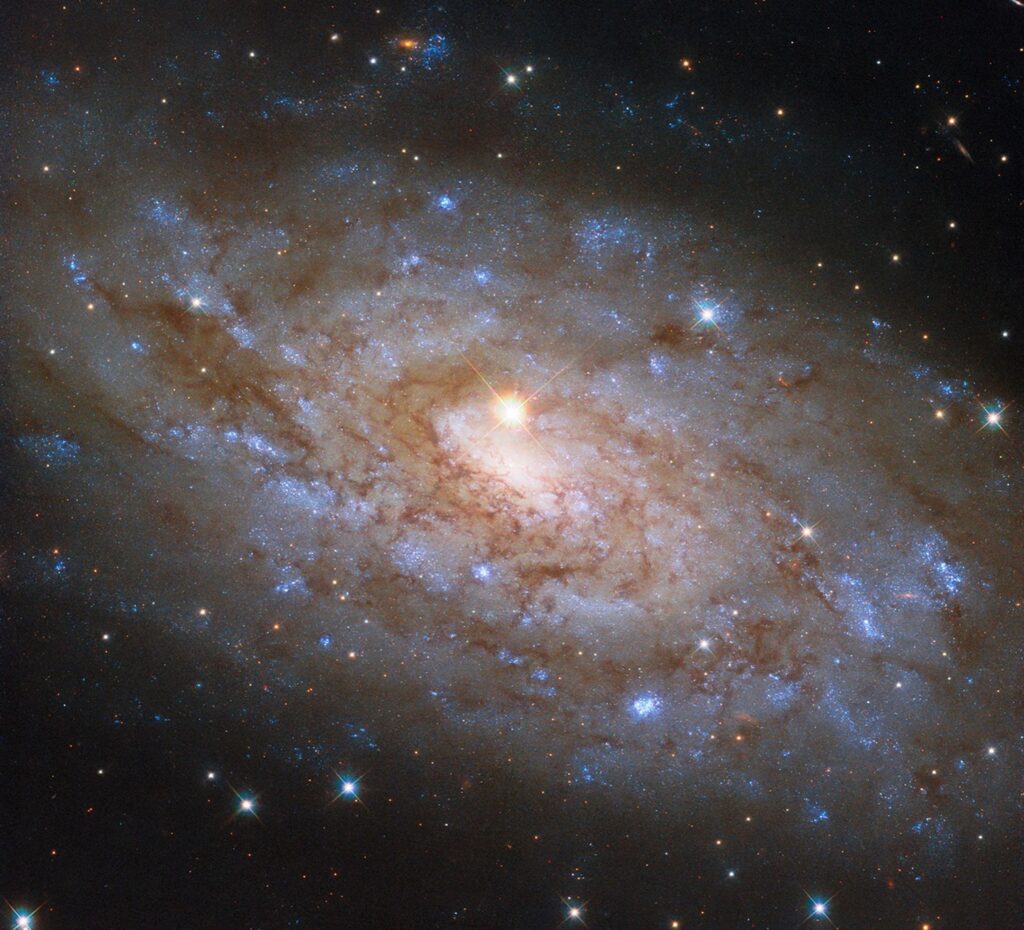
Introduction
The Hubble Space Telescope, a tireless explorer of the cosmos, has once again provided us with a breathtaking image: NGC 5530, a spiral galaxy residing 40 million light-years away in the constellation Lupus. This isn’t just another pretty picture, however. NGC 5530 presents a captivating cosmic illusion alongside a remarkable tale of amateur astronomical discovery, showcasing the surprising twists and turns that characterize our explorations of the universe.
The Illusion at the Heart of NGC 5530
At first glance, NGC 5530 appears to possess a bright, central core, a common feature often associated with the powerful activity of a supermassive black hole. This impression, however, is a clever trick of perspective. The seemingly bright center of NGC 5530 isn’t fueled by a galactic behemoth; instead, it’s a star far closer to home – a seemingly insignificant celestial neighbor located a mere 10,000 light-years from Earth. This chance alignment, a cosmic coincidence of epic proportions, creates the illusion that this foreground star is nestled within the heart of the distant galaxy.
The discovery of this illusion highlights a crucial aspect of astronomical observation: our perspective. The sheer scale of the universe often deceives us, leading to misinterpretations based on our limited vantage point. What appears to be a central galactic feature from our position could, in reality, be a completely unrelated object much closer to us. This emphasizes the importance of careful analysis, combining observational data with sophisticated modeling and understanding of cosmic distances to unravel the true nature of celestial objects.
NGC 5530’s Flocculent Structure and the Mystery
NGC 5530 is classified as a flocculent spiral galaxy. Unlike grand design spirals with clearly defined, continuous spiral arms, flocculent galaxies like NGC 5530 possess patchy, irregular arms. These fragmented arms, a result of complex gravitational interactions and gas dynamics within the galaxy, present a visually stunning yet more challenging puzzle for astronomers. The irregularities in NGC 5530’s spiral structure offer invaluable clues to understanding the processes of star formation and galactic evolution, particularly in environments with less uniform distributions of matter.
The study of this NGC flocculent structure provides insights into the intricate interplay of gravity, gas density, and stellar formation. Astronomers use sophisticated modeling techniques and observations across various wavelengths to unravel the processes that shape these irregular spiral arms. By studying NGC 5530, and other flocculent galaxies, we can refine our understanding of galactic evolution and the complex interplay of forces that governs the formation and distribution of stars within galaxies.
A Supernova Surprise: SN 2007IT and the Diligence of Robert Evans
The story of NGC 5530 doesn’t end with the illusion of its central star. On September 13, 2007, Australian amateur astronomer Robert Evans made a remarkable discovery while observing NGC 5530: a supernova, later designated SN 2007IT. Evans, renowned for his meticulous observational techniques, painstakingly compared the galaxy’s current appearance to archival reference images, revealing the subtle but significant change indicating a supernova explosion within NGC 5530.
This discovery highlights the critical role amateur astronomers play in professional astronomy. Their dedicated observations, often undertaken with smaller telescopes and limited resources, frequently provide the first indications of transient events like supernovae. Evans’ discovery of SN 2007IT is one of over 40 supernovae he’s identified using this painstaking comparative method, a testament to his dedication, observational skills, and patience.
The timing of Evans’ discovery adds another layer of intrigue. The light from SN 2007IT, having traveled 40 million years to reach Earth, likely arrived just days before Evans’ observation. This serendipitous timing underscores the vastness of cosmic distances and the remarkable precision required to detect such fleeting events. The discovery of SN 2007IT in NGC 5530 not only adds to our understanding of supernovae but also emphasizes the importance of continuous, long-term monitoring of the night sky.
NGC 5530: A Window into Galactic Processes
The study of NGC 5530 offers a unique opportunity to investigate various aspects of galactic evolution, star formation, and the dynamics of spiral galaxies. The chance alignment of the foreground star provides a valuable lesson about observational biases and the importance of critically evaluating astronomical data. The discovery of SN 2007IT highlights the essential contributions of amateur astronomers and the serendipitous nature of scientific discoveries.
Further research into NGC 5530, using data from Hubble and other powerful telescopes, will undoubtedly unveil further secrets about this intriguing galaxy. By studying its structure, its star formation rate, and the chemical composition of its gas and dust, we can gain a deeper understanding of the processes that shape galaxies like NGC 5530 and, in turn, our own Milky Way. The ongoing investigation of NGC 5530 promises to yield further insights into the dynamic and ever-evolving universe we inhabit.
Your blog is like a beacon of light in the vast expanse of the internet. Your thoughtful analysis and insightful commentary never fail to leave a lasting impression. Thank you for all that you do.